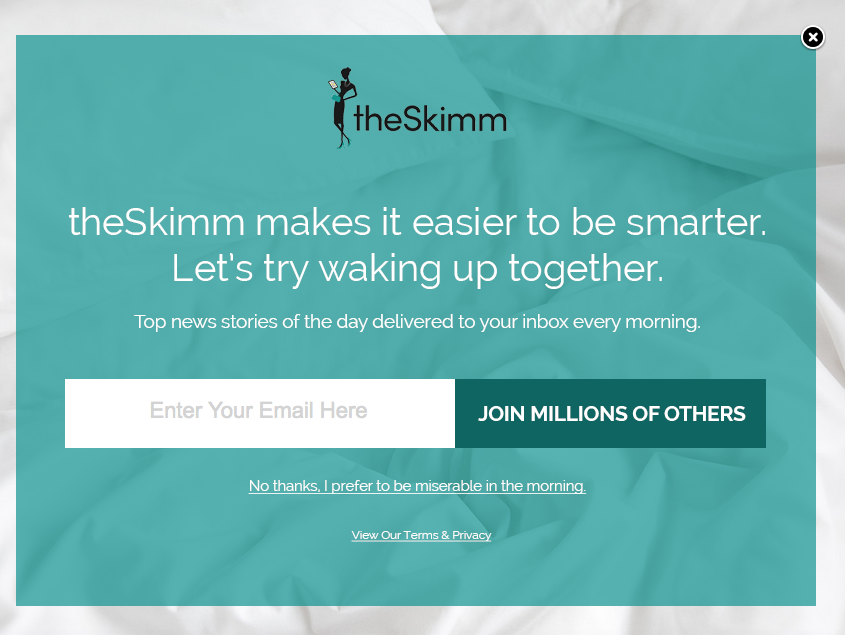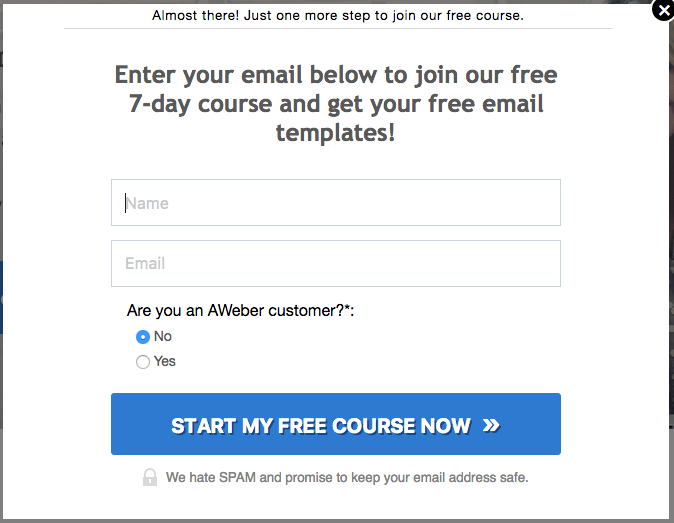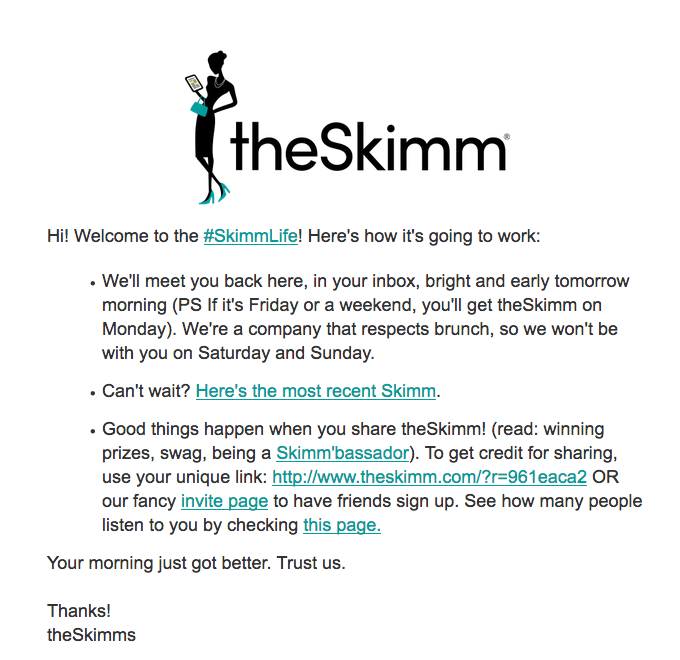Email automation — everyone’s doing it! Or at least they should be. Ninety percent of marketers say email automation is key to success.
And yet, according to Forbes, less than 10 percent of companies use marketing automation.
If you’re not already familiar with the benefits of email automation, it’s time to get on board. Automated emails are great for building a relationship with your audience, driving engagement and increasing conversions.
Ready to find out how to get started with email automation? Read this post to get 6 easy steps.
1. Start collecting subscribers.
Before you can get started with email automation, people need to sign up for your autoresponder series. A robust, permission-based list of subscribers is key to running a profitable automated email campaign.
By placing sign up forms on your blog, website or social media channels, you can begin generating leads and building the right audience for your emails.
On your forms, be sure to explain what subscribers can expect from your emails and how they’ll provide value.
For example, this sign up form from theSkimm explains the value of subscribing by mentioning that it’ll be “easier to be smarter,” because you’ll be receiving the top news stories of the day. It then sets expectations by explaining that you’ll receive an email from them every morning.

After people subscribe, make sure your emails live up to their expectations. If you don’t, you’ll likely alienate subscribers, decrease engagement and hurt your email marketing efforts.
Ultimately, your sign up form should make opting into an email list as easy as possible. I also recommend throwing in freebies — like ebooks or coupon codes — to create an extra incentive for signing up.
Creating an effective sign up form may seem daunting at first. But with concise copy, an eye-catching design, a clear call-to-action and a dash of creativity, people won’t be able to resist signing up for your automated email series!
2. Send relevant automated emails with segmentation.
Think back to the last time you sent an email to an entire subscriber list. Maybe it yielded some results, but perhaps it would’ve performed even better if you’d targeted a specific niche within your contacts.
Enter segmentation — one of our favorite ways to run successful automated email campaigns.
With segmentation, you can divide subscribers into highly-specific subgroups based on criteria like age, geographic location, occupation and interests. You can then send them automation series designed for their unique needs.
For example, for our free email course, What to Write in Your Emails, we use an automation series to automatically deliver the course emails. We wanted to segment the subscribers who received this course into two separate groups – our customers and non-customers – so we could send them different automated emails aligned with their specific needs.
To accomplish this, we asked people to identify whether or not they were a customer on the sign up form. We then set up two different automation series in AWeber that triggered based on their answer. If they said they were a customer, they received our customer automation series. If they said they were not, we sent them the other series.

Beyond sending more relevant, targeted emails, segmentation tends to get more conversions than messages directed at a wider audience. According to the Direct Marketing Association, targeted emails can drive up to 77 percent of your overall email ROI. For email marketers, it’s a win-win!
3. Embrace personalization.
There’s a lot of buzz about personalization — and for good reason. According to Marketing Land, personalized emails see an open rate that’s nine percent higher than those written for larger audiences. They also saw a 41 percent higher click-through rate.
Subscribers don’t just want relevant and authentic content. They expect it, which means your content needs to speak to them directly, answer their questions and align with their unique interests.
Personalization goes well beyond including someone’s name in a subject line. There are tons of great ways to utilize personalization in your automated emails, including:
- Targeting users with relevant educational courses.
- Linking campaigns to move subscribers to a new automated email series when another one ends.
- Creating multiple email campaigns for different incentives.
4. Engage new subscribers with a welcome email series.
Engaging people as soon as they join your list is one of the most compelling reasons why you should get started with automated emails. By sending a series of three to five friendly and helpful welcome emails, you can begin nurturing new leads the moment they subscribe.
Welcome emails are great for getting subscribers excited about the content you’re sending. By teasing some of your highest performing blogs, ebooks or social media posts, you can show subscribers that joining your list was a smart decision.
First impressions are lasting impressions, so it’s crucial your initial welcome email sets the right tone with subscribers.
Make sure you introduce yourself and provide contact information. Write to subscribers the way you’d write to a friend, deliver your lead magnet if you promised one and be transparent about what kind of content you’ll be sending. And finally, thank subscribers for joining your list.
Here is the welcome email theSkimm sends right after you fill out their sign up form. It’s concise and to the point but sets expectations and introduces theSkimm’s fun and conversational writing tone.

5. Send subscribers valuable content for free.
Are you a self-proclaimed foodie with an affinity for Italian cuisine, or are you a devout yogi with several years of teaching under your belt?
It doesn’t matter what you’re an expert in. If you’re a thought leader in a certain area, use automated emails to share your passion and knowledge with the world!
Send free and valuable content (like recent blog posts) to answer your audience’s biggest questions. Giving away content that addresses a specific problem helps build trust with subscribers, allowing you to maintain healthy relationships with them.
The trick is to use content to solve people’s problems. If you establish yourself as an authoritative source, subscribers will keep coming back to you in the future.
6. Link campaigns together to increase your ROI.
Let’s say you have a series of four automated emails set up for when people first subscribe to your list. Once that email series ends, try adding subscribers to another automated series to keep them engaged.
With Campaigns, AWeber’s email automation platform, you can automatically move subscribers from one series to another to improve engagement with your messages.
Using Campaigns, you can tag all the subscribers who reach the end of your first email series, moving them into a second series automatically. After the second series ends, you can move them into a third series, fourth series, fifth series and so on.
Linking email campaigns together provides several benefits. But most importantly, it will help you:
- Send the right content to the right people
- Create a more personalized experience based on how people engage with your emails
- Engage subscribers over longer time periods
- Encourage past customers to make future purchases
(Interested in learning more about Campaigns? Check out this post to learn about the many ways Campaigns can help increase email marketing engagement and conversions.)
Work smarter, not harder.
Email automation is a small investment that could have a serious impact on your business. When used properly, email automation can create a deeper, more personalized relationship with subscribers, save your time and increase conversions.
Ready to get started with email automation? Sign up for your free trial of AWeber today!
